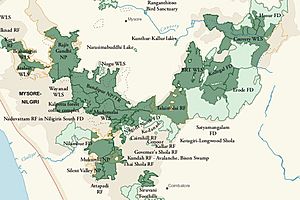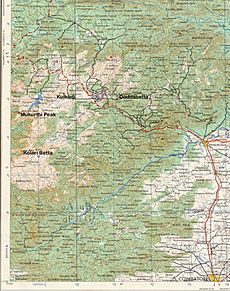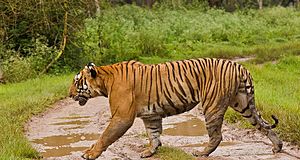Nilgiri Mountains facts for kids
Quick facts for kids Nilgiri Mountains |
|
|---|---|
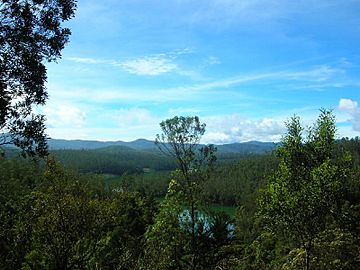
View of Nilgiri Mountains and its forests
|
|
| Highest point | |
| Peak | Doddabetta (Tamil Nadu, India) |
| Elevation | 2,637 m (8,652 ft) |
| Listing | Ultra List of Indian states and territories by highest point |
| Naming | |
| English translation | Blue Mountains in Kannada |
| Geography | |
| Location | Tamil Nadu, Kerala, Karnataka |
| Parent range | Western Ghats Eastern Ghats |
| Geology | |
| Age of rock | Archean Eon, 3000 to 500 mya |
| Mountain type | Fault |
| Climbing | |
| Easiest route | NH 67 (Satellite view) or Nilgiri Mountain Railway |
The Nilgiri Mountains are a mountain range in India. They are found in the states of Tamil Nadu, Karnataka, and Kerala. These mountains connect two other important ranges: the Western Ghats and the Eastern Ghats.
The Nilgiri Mountains have many tall peaks. At least 24 of them are over 2,000 meters (6,560 feet) high. The very highest point is Doddabetta Peak, which stands at 2,637 meters (8,652 feet).
Contents
What's in a Name?
The name Nilgiri comes from two old Sanskrit words. Neelam means "blue" and giri means "mountain." So, Nilgiri means "Blue Mountains." People have used this name since at least the year 1117 CE.
It is believed that the name comes from the bluish flowers of the kurinji shrubs. These flowers cover the hills and make them look blue.
Where are the Nilgiri Mountains?
The Nilgiri Hills are located south of the Mysore Plateau. The Moyar River separates them from this plateau in the north.
Protected Areas
Several national parks are found around the Nilgiri Mountains. These parks help protect the animals and plants that live there.
- Mudumalai National Park is in the northern part of the range. It covers an area of 321 square kilometers (124 sq mi). This park is where the states of Kerala, Karnataka, and Tamil Nadu meet.
- Mukurthi National Park is in the southwest, in Kerala. It covers 78.5 square kilometers (30.3 sq mi). This park protects special grasslands and forests. It is home to the Nilgiri tahr, a type of mountain goat.
- Silent Valley National Park is just south of these two parks. It covers 89.52 square kilometers (34.56 sq mi).
Protecting Nature
The Nilgiri Hills are part of the Nilgiri Biosphere Reserve. This reserve is a special protected area in India. It is also part of the UNESCO World Network of Biosphere Reserves. This means it is recognized internationally for its important natural environment.
A Look Back in Time
People have lived in the high areas of the Nilgiri Hills for a very long time. We know this because many old tools and items have been found there. Some of these ancient artifacts are now kept in the British Museum.
The name Nila was first used for this region in 1117 CE. A general from the Hoysala kingdom mentioned it in a report. He said he offered the peak of Nila Mountain to the goddess Lakshmi.
Early Explorers
In 1814, two explorers, Keys and McMahon, climbed the hills. They made maps and reported what they found. Later, two young British officers, Whish and Kindersley, explored the area more. They were impressed by the good climate and beautiful land.
British Influence
After the 1820s, the British developed the hills quickly. It became a popular place for them to visit in summer. In 1827, Ooty became the official summer capital of the Madras Presidency. Many winding roads were built through the hills. In 1899, the Nilgiri Mountain Railway was finished. This train line made it easier to travel to the mountains.
Tallest Peaks in the Nilgiris
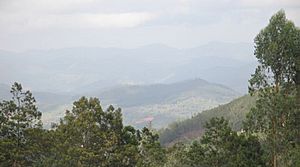
The highest point in the Nilgiris is Doddabetta Peak. It is 2,637 meters (8,652 feet) tall. It is located about 4 kilometers (2.5 miles) southeast of Udhagamandalam (also known as Ooty).
Other important peaks near Udhagamandalam include:
- Kolaribetta: 2,630 meters (8,629 feet)
- Makurni: 2,594 meters (8,510 feet)
- Hecuba: 2,375 meters (7,792 feet)
- Kattadadu: 2,418 meters (7,933 feet)
- Kulkudi: 2,439 meters (8,002 feet)
Snowdon is another high peak, 2,530 meters (8,301 feet) tall, located in the northern part of the range. Club Hill (2,448 meters / 8,031 feet) and Elk Hill (2,466 meters / 8,091 feet) are also important. These three peaks, along with Doddabetta, create the beautiful Udhagamandalam Valley.
Devashola is a peak known for its blue gum trees. It is 2,261 meters (7,418 feet) high.
Amazing Waterfalls
The Nilgiri Mountains are home to many beautiful waterfalls.
- The highest is Kolakambai Fall. Its water drops 400 feet (120 meters) without breaking.
- Nearby is the Halashana falls, which is 150 feet (46 meters) high.
- The second highest is Catherine Falls, near Kotagiri. It has a 250-foot (76-meter) drop. It is named after the wife of M.D. Cockburn, who brought coffee plants to the Nilgiri Hills.
- The Upper and Lower Pykara falls are 180 feet (55 meters) and 200 feet (61 meters) high.
- The Kalhatti Falls is 170 feet (52 meters) high.
- Law's Fall, near Coonoor, is named after Major G. C. Law. He helped build the Coonoor Ghat road.
Plants and Animals of the Nilgiris
The Nilgiris are full of life! They have over 2,800 types of flowering plants and 160 types of ferns. Many other plants, mosses, fungi, and lichens also grow here. No other hill station in India has so many different species.
Mammals
Many amazing mammals live in the Nilgiris. These include the powerful Bengal tiger and the huge Indian elephant. You can also find the Indian leopard, chital deer, and gaur (Indian bison). Other animals are the sambar deer, dhole (wild dog), and golden jackal. The Nilgiri tahr, a special mountain goat, also lives here.
Reptiles and Amphibians
The Nilgiris are home to many reptiles. These include the Indian python, king cobra, and Indian cobra. You might also see the Malabar pit viper and the mugger crocodile. For amphibians, there's the unique purple frog and the Malabar gliding frog. It is the only place in South India where you can find the rare white tiger.
Birds
Many beautiful birds fly in the Nilgiris. Some examples are the colorful Indian peacock, the Malabar pied hornbill, and the great hornbill. You can also spot the Nilgiri wood pigeon and the Indian vulture.
Habitats and Challenges
The main type of forest here is the tropical rainforest. You can also find montane forests, which are forests found in mountains. Sadly, many of these forests have been damaged. This is due to large tea plantations, easy access for vehicles, and planting of non-native trees like eucalyptus.
Threatened Plants
Some plants in the Nilgiris are in danger of disappearing.
- Vulnerable species: Miliusa nilagirica, Nothapodytes foetida, Commelina wightii
- Rare species: Ceropegia decaisneana, Ceropegia pusilla, Senecio kundaicus
- Endangered species: Youngia nilgiriensis, Impatiens neo-barnesii, Impatiens nilagirica, Euonymus angulatus and Euonymus serratifolius.
Images for kids
-
Herd of Gaur, Indian bisons in Mudumalai National Park
See also
 In Spanish: Montañas Nilgiri para niños
In Spanish: Montañas Nilgiri para niños


